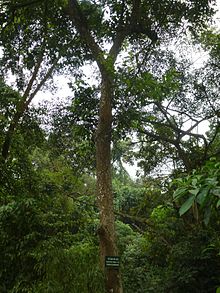Castanopsis indica
| Castanopsis indica | |
|---|---|

| |
| Scientific classification | |
| Kingdom: | Plantae |
| Clade: | Tracheophytes |
| Clade: | Angiosperms |
| Clade: | Eudicots |
| Clade: | Rosids |
| Order: | Fagales |
| Family: | Fagaceae |
| Genus: | Castanopsis |
| Species: | C. indica
|
| Binomial name | |
| Castanopsis indica (Roxburgh ex Lindl.) A. DC.
| |
| Synonyms[2] | |
| |
Castanopsis indica is a tree in the family Fagaceae.
Description
[edit]Castanopsis indica is a tallish tree, growing up around 8–14 m (26–46 ft) in height with a dense, full crown. The leaves are thick and leathery with a serrated edge. They are oblong and elliptical, with an acute tip, are nearly evergreen and have a short petiole. The bark of the tree is rough and grey. The fruit is reddish-brown and round, found in small clusters, and is covered with long, thin spines. The fruit is often fed upon by squirrels.[3]
The tree can be found between 300–1,000 m (980–3,280 ft) above sea level.[3]
Distribution and habitat
[edit]Castanopsis indica grows naturally in Nepal, Bhutan to Taiwan.[4]
Uses
[edit]The nuts of the tree are considered edible. The wood is locally used in construction and the bark can be used in tanning.[5] In Nepal the leaves are used to wrap things.[6]
References
[edit]- ^ Yu, S.; Botanic Gardens Conservation International (BGCI) & IUCN SSC Global Tree Specialist Group (2019). "Castanopsis indica". IUCN Red List of Threatened Species. 2019: e.T138592702A147642846. Retrieved 23 January 2023.
- ^ Umberto Quattrocchi (2016). CRC World Dictionary of Medicinal and Poisonous Plants: Common Names, Scientific Names, Eponyms, Synonyms, and Etymology (reprint ed.). CRC Press. p. 847. ISBN 9781482250640.
- ^ a b Prisentjit Das Gupta (2011). Touching Trees: A Field Guide to Common Forest Trees in India. Sanbun Publishers. p. 68. ISBN 9789380213514.
- ^ "Castanopsis indica". World Checklist of Selected Plant Families (WCSP). Royal Botanic Gardens, Kew. Retrieved 23 February 2018.
- ^ Castanopsis indica - Useful Tropical Plants
- ^ S. S. Negi, Sharad Singh Negi (1994). Forests and Forestry in Nepal (illustrated ed.). APH Publishing. p. 183. ISBN 9788170245810.

